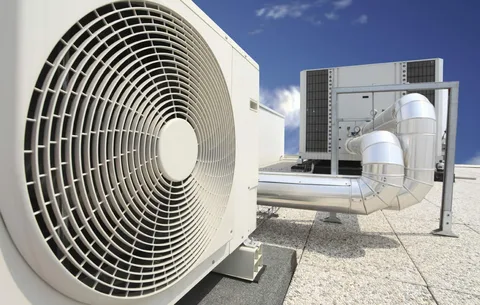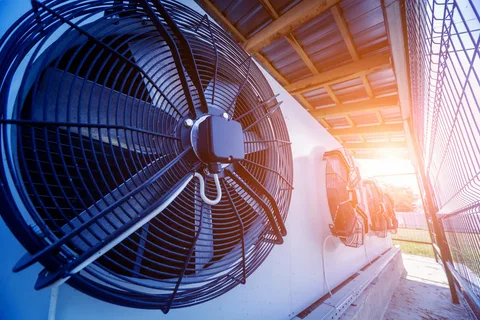Indoor air quality is a crucial aspect of everyday life, yet it often goes overlooked. From cooking odors to allergens and pollutants, the air inside our homes can significantly impact our health and comfort. That’s why it’s essential to have a reliable ventilation system in place. Whether you’re looking to improve the air quality in your home or want to stay cool and comfortable, high-performance Ventilation Fan is the perfect solution. This blog post will explore the options available and how these powerful, energy-efficient fans can enhance your home and provide you with the fresh, clean air you deserve. So, let’s take a deep breath and dive into the world of Ventilation-Fans.
Understanding Ventilation-Fans
Ventilation-Fans are essential for maintaining good indoor air quality. They remove stale air and odors from your home and replace them with fresh air from outside. These fans are designed to be installed in various areas of your home, such as bathrooms, kitchens, and laundry rooms, where moisture, smoke, and cooking odors are common.
- One important aspect of understanding Ventilation-Fans is their ability to remove allergens and pollutants from the air. This is especially beneficial for individuals with allergies or respiratory issues, as it can help improve their overall health and well-being.
- Another key aspect of Ventilation-Fans is their ability to prevent excess moisture build-up. Moisture can lead to the growth of mold and mildew, which can be harmful to both your health and the structural integrity of your home. Ventilation-Fans help to reduce humidity levels and prevent these issues from occurring.
Understanding Ventilation-Fans also means recognizing their energy efficiency. Many high-performance fans are designed to consume less energy while providing powerful airflow. This not only saves you money on your energy bills but also helps to reduce your carbon footprint.
The Importance of Indoor Air Quality
Regarding our health and well-being, indoor air quality is something we can’t afford to overlook. The air inside our homes can contain a variety of pollutants and allergens that can hurt our respiratory system, allergies, and overall quality of life. Poor indoor air quality can lead to various health issues, including asthma, allergies, and respiratory infections.
That’s why it’s crucial to prioritize and improve indoor air quality. Investing in a high-performance Ventilation-Fan can effectively remove pollutants and allergens from your home, ensuring that the air you and your family breathe is clean and fresh.
In addition to protecting our health, indoor air quality also plays a role in our comfort. Poor air quality can lead to unpleasant odors, stuffy rooms, and a generally uncomfortable living environment. Investing in a Ventilation-Fan can eliminate these issues and create a more comfortable and pleasant atmosphere in your home.
Energy Efficiency – A Key Feature of Ventilation-Fans
When choosing the right Ventilation-Fan for your home, energy efficiency is key. Not only does an energy-efficient fan save you money on your utility bills, but it also helps to reduce your carbon footprint. Opting for a high-performance fan that consumes less energy allows you to enjoy powerful airflow without compromising environmental sustainability.
Energy-efficient Ventilation-Fans are designed to operate at lower power levels while still effectively removing stale air, odors, and allergens from your home. They have advanced features such as efficient motors, variable speed controls, and timers to optimize energy usage.
Investing in an energy-efficient fan benefits your wallet and the planet and ensures a comfortable and healthy living environment. With their powerful airflow and low energy consumption, these fans provide the best of both worlds – fresh, clean air and reduced energy costs.
Choosing the Right Ventilation-Fan for Your Home
When choosing the right Ventilation-Fan for your home, there are a few factors to consider.
- First, you’ll want to determine the fan size you need. The size of the room will dictate the airflow capacity required to ventilate the space effectively. Generally, larger rooms will require more powerful fans.
- Next, think about the specific needs of each area in your home. For example, if you’re looking to install a fan in your bathroom, you’ll want one designed to handle moisture and prevent mold and mildew build-up. On the other hand, if you want to improve the air quality in your kitchen, a fan with strong odor-removal capabilities would be ideal.
- It’s also important to consider noise levels. Look for fans designed to operate quietly, especially if you plan on installing them in bedrooms or other areas where noise could be disruptive.
- Lastly, remember aesthetics. Ventilation-Fans come in various styles and finishes, so you can choose one that seamlessly blends into your home’s décor.
Installation Tips for Ventilation-Fans
When installing Ventilation-Fans in your home, a few tips can help ensure a smooth and effective installation process.
- First, make sure you carefully read and follow the manufacturer’s instructions. Each fan may have specific requirements and recommendations that you need to follow to ensure optimal performance.
- Before beginning the installation, assess where you plan to install the fan. Ensure sufficient space and access for the fan to function properly. Additionally, check for any obstructions, such as wiring or pipes that may interfere with the installation process.
- It’s important to have the necessary tools and equipment before starting the installation. This may include a screwdriver, wire cutters, and a ladder if needed. Having these tools ready will save you time and frustration during installation.
- When wiring the fan, ensure that you follow proper electrical safety procedures. If you are not comfortable working with electrical wiring, hiring a professional electrician for the installation is recommended.
Once the fan is installed, test it to ensure it functions properly. Ensure it effectively removes stale air and odors and replaces them with fresh air. Additionally, check for any excessive noise or vibrations, which may indicate an installation issue.
Maintenance of Ventilation-Fans for Optimal Performance
Regular maintenance is essential to ensure optimal performance and longevity of your Ventilation-Fan. Here are a few maintenance tips to keep your fan running smoothly:
- Clean the fan blades and housing regularly to remove dust and debris that can accumulate over time. This will help maintain proper airflow and prevent the fan from becoming clogged or inefficient.
- Check the fan’s filters regularly and replace them as needed. Filters play a crucial role in removing allergens and pollutants from the air, so keeping them clean and in good condition is vital for optimal performance.
- Inspect the fan’s motor and wiring for any signs of damage or wear. If you notice any issues, it’s important to address them promptly to prevent further damage and ensure the fan continues to operate safely.
- Lubricate the fan’s moving parts, such as bearings and motor shafts, to reduce friction and ensure smooth operation. Consult the manufacturer’s instructions for the recommended lubrication method and schedule.
- Test the fan’s functionality periodically at all available speeds. Listen for any unusual noises or vibrations, as these may indicate a problem that needs to be addressed.
Maximizing Ventilation Fan Benefits with Smart Usage
Smart usage is key when it comes to getting the most out of your Ventilation-Fan. By incorporating a few simple strategies, you can further maximize the benefits and enhance your indoor air quality.
- First, ensure you’re using your Ventilation Fan consistently in areas where moisture, odors, and pollutants are common. Whether it’s the bathroom after a shower or the kitchen during cooking, running the fan during and after these activities will ensure that stale air and pollutants are effectively removed.
- Consider using your fan on a timer or with a humidity sensor. This way, you can automate the fan’s operation and ensure it runs when needed most. This saves energy and guarantees that your indoor air quality remains at its best.
Remember to clean and maintain your Ventilation-Fan regularly. Dust and debris can accumulate over time and hinder the fan’s performance. Keeping the blades and housing clean will ensure the fan can effectively circulate air and remove pollutants.
The Benefits of Investing in High-Quality Ventilation-Fans
Investing in high-quality Ventilation-Fans for your home comes with many benefits beyond simply improving indoor air quality. These fans are designed to provide powerful airflow, remove allergens and pollutants, and reduce excess moisture. But the benefits continue beyond there.
First and foremost, high-quality Ventilation-Fans ensure a healthier living environment. By effectively removing pollutants and allergens from the air, these fans help prevent respiratory issues and allergies, improving overall health and well-being. Additionally, by reducing humidity levels, they prevent the growth of mold and mildew, safeguarding both your health and the structural integrity of your home.
Energy efficiency is another significant benefit of investing in high-quality Ventilation-Fans. These fans are designed to consume less energy while still delivering powerful airflow. This saves you money on energy bills and reduces your carbon footprint, making your home more environmentally friendly.
In addition to the health and energy-saving benefits, high-quality Ventilation-Fans also contribute to a more comfortable living environment. They eliminate unpleasant odors and stuffy rooms and create a fresh and pleasant atmosphere throughout your home.
FAQ’s
Curious minds want to know! Here are the answers to some frequently asked questions about Ventilation-Fans:
1. How often should I clean my Ventilation-Fan?
It’s a good idea to clean your Ventilation-Fan every three to six months. Regular cleaning ensures optimal performance and prevents dust and debris from accumulating, which can affect airflow.
2. Can I install a Ventilation Fan myself?
Yes, many Ventilation fan comes with straightforward instructions and can be easily installed by a confident DIYer. However, if you need more clarification or are uncomfortable working with electrical wiring, it’s best to hire a professional electrician for the installation.
3. Can a Ventilation-Fan help reduce energy costs?
Absolutely! Energy-efficient Ventilation-Fans are designed to consume less energy while providing powerful airflow. Investing in an energy-efficient fan can reduce your energy bills and decrease your carbon footprint.
4. Can a Ventilation-Fan be used in any room?
Ventilation-Fans are typically used in areas with high moisture, odors, or pollutants, such as bathrooms, kitchens, and laundry rooms. However, they can also be used in rooms where air quality needs improvement, such as basements or workshops.
5. Do Ventilation-Fans make a lot of noise?
Not all Ventilation-Fans are created equal when it comes to noise levels. Look for fans designed to operate quietly, especially if you plan to install them in bedrooms or other areas where noise could be a concern. Read reviews and specifications to ensure you choose a fan that meets your noise preference.
Conclusion
Incorporating high-performance Ventilation Fan into your home is a game-changer regarding indoor air quality and comfort. By understanding the benefits of these fans, such as their ability to remove pollutants, prevent mold growth, and save energy, you can make an informed decision about which fan is right for you. Remember to consider factors like room size, specific needs, noise levels, and aesthetics when choosing a fan. And remember to install and maintain your fan to ensure optimal performance properly. With the right Ventilation-Fan, you can breathe easily and enjoy a healthier, more comfortable living environment.

